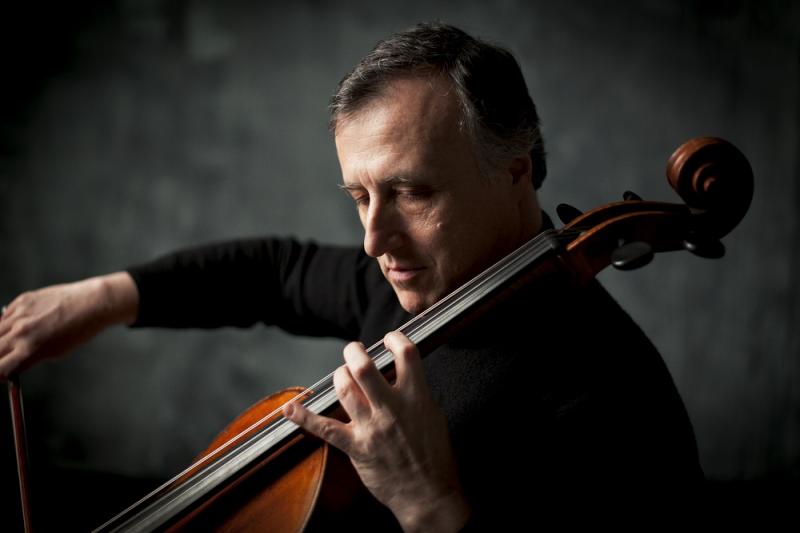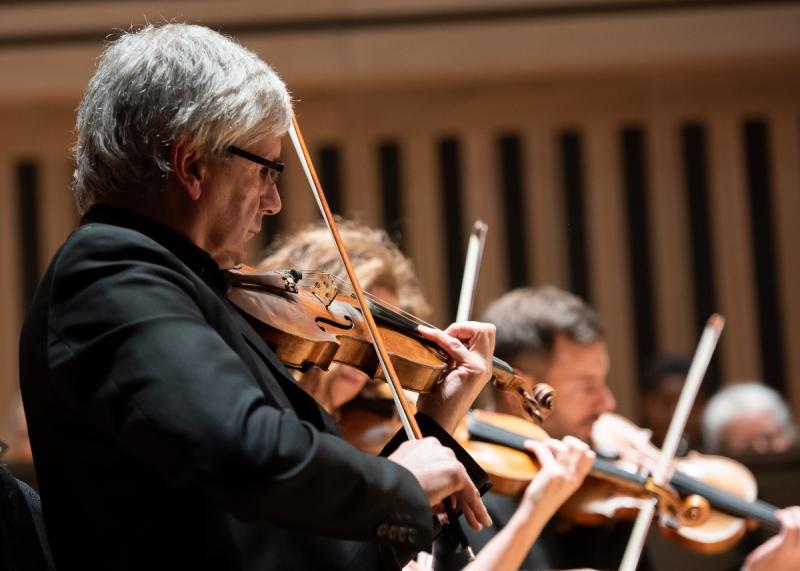Wallfisch, Northern Chamber Orchestra, Stoller Hall, Manchester review - Weinberg UK premiere | reviews, news & interviews
Wallfisch, Northern Chamber Orchestra, Stoller Hall, Manchester review - Weinberg UK premiere
Wallfisch, Northern Chamber Orchestra, Stoller Hall, Manchester review - Weinberg UK premiere
Subtlety and haunting qualities in a little gem for solo cello and string orchestra

Everyone’s doing Weinberg now, or so it seems. The Polish-born composer who became a close friend of Shostakovich was born 100 years ago, and there’s plenty of his music to go round.
At 16 minutes in length but still with four movements, the piece is certainly an attractive addition to the fairly limited repertoire of concertos for cello and orchestra. And it has some unique and intriguing qualities. It seems almost monothematic in each movement, based on clear melodies and mainly traditional, tonal harmonic language. But there are subtleties: the opening Adagio, beginning as a melancholy minor-scale solo song over muted string chords (and then repeated, as all good song tunes should be), seems the very soul of tradition – but, after an intense climax of emotion for the soloist, it returns in spicier guise. Nothing to frighten the horses, but a hint of deeper forces at work than might have at first appeared.
The second movement is another folk-like song, with an unmistakable Habanera rhythm, showing soloist and orchestra in dialogue and something very like variation style. The third, Allegro vivace, is a dance-like scherzo, still minor-key, with alternating solo-tutti presentations of its tune and developments, this time with Middle Eastern sounding inflexions in the scale, perhaps related to Weinberg’s own Jewish heritage.
That quality continues in the solo cadenza which follows and links to the very solemn final Adagio, a conclusion that is moving and finally haunting (though with just a hint of peace in its last, major, chord). You can’t help but think there’s a link to the post-Holocaust context of the original work’s creation. It may sound a miserable piece of work, but it isn’t. The craftsmanship and skilful ambiguities of the writing are appealing, and of course it’s concentrated and compact – a lot of ground is traversed in a short time.  Wallfisch offered good value for money, as not only did he play the Weinberg work’s solo with his customary eloquence and nobility, but he also performed the solo in Tchaikovsky’s Variations on a Rococo Theme. He prefers, like many soloists today, Tchaikovsky’s original version of the work, rather than the adaptation by Wilhelm Fitzenhagen which became its published and for many years only form. It’s a great piece for a gifted soloist, and his eloquent melodic playing in variation three, impeccable harmonics in variation five and glorious cantabile in variation seven were joys to hear.
Wallfisch offered good value for money, as not only did he play the Weinberg work’s solo with his customary eloquence and nobility, but he also performed the solo in Tchaikovsky’s Variations on a Rococo Theme. He prefers, like many soloists today, Tchaikovsky’s original version of the work, rather than the adaptation by Wilhelm Fitzenhagen which became its published and for many years only form. It’s a great piece for a gifted soloist, and his eloquent melodic playing in variation three, impeccable harmonics in variation five and glorious cantabile in variation seven were joys to hear.
His virtues were matched by the playing of the Northern Chamber Orchestra (conductor-less, as always, under the first-desk leadership of Nicholas Ward, pictured above), with horn and flute solos outstanding. The NCO on their own began and ended the concert with two highly popular mainstream works (both first written by school-teachers for non-professionals, as it happens). They’re still building their audience in a relatively new concert series at the Stoller Hall in Chetham’s School of Music (the programme is also being repeated tonight in Macclesfield, where they are established visitors and often sell out), so these choices help.
Their quality of chamber music-style listening to each other’s sound and forging an interpretation collectively were to the fore in Holst’s St Paul’s Suite: in the Stoller Hall 19 strings can make a formidable unison and a rich spread of tone when they want to. I liked their dynamic contrasts and the way the “Greensleeves” tune stayed half-hidden in the texture on its first appearance in the Finale. Schubert’s Fifth Symphony brought sprightly pacing and a sense of unalloyed joy to the conclusion of the concert.
rating
Explore topics
Share this article
The future of Arts Journalism
You can stop theartsdesk.com closing!
We urgently need financing to survive. Our fundraising drive has thus far raised £49,000 but we need to reach £100,000 or we will be forced to close. Please contribute here: https://gofund.me/c3f6033d
And if you can forward this information to anyone who might assist, we’d be grateful.

Subscribe to theartsdesk.com
Thank you for continuing to read our work on theartsdesk.com. For unlimited access to every article in its entirety, including our archive of more than 15,000 pieces, we're asking for £5 per month or £40 per year. We feel it's a very good deal, and hope you do too.
To take a subscription now simply click here.
And if you're looking for that extra gift for a friend or family member, why not treat them to a theartsdesk.com gift subscription?
more Classical music
 Scottish Chamber Orchestra, Ibragimova, Queen’s Hall, Edinburgh review - rarities, novelties and drumrolls
A pity the SCO didn't pick a better showcase for a shining guest artist
Scottish Chamber Orchestra, Ibragimova, Queen’s Hall, Edinburgh review - rarities, novelties and drumrolls
A pity the SCO didn't pick a better showcase for a shining guest artist
 Kilsby, Parkes, Sinfonia of London, Wilson, Barbican review - string things zing and sing in expert hands
British masterpieces for strings plus other-worldly tenor and horn - and a muscular rarity
Kilsby, Parkes, Sinfonia of London, Wilson, Barbican review - string things zing and sing in expert hands
British masterpieces for strings plus other-worldly tenor and horn - and a muscular rarity
 From Historical to Hip-Hop, Classically Black Music Festival, Kings Place review - a cluster of impressive stars for the future
From quasi-Mozartian elegance to the gritty humour of a kitchen inspection
From Historical to Hip-Hop, Classically Black Music Festival, Kings Place review - a cluster of impressive stars for the future
From quasi-Mozartian elegance to the gritty humour of a kitchen inspection
 Shibe, LSO, Adès, Barbican review - gaudy and glorious new music alongside serene Sibelius
Adès’s passion makes persuasive case for the music he loves, both new and old
Shibe, LSO, Adès, Barbican review - gaudy and glorious new music alongside serene Sibelius
Adès’s passion makes persuasive case for the music he loves, both new and old
 Anja Mittermüller, Richard Fu, Wigmore Hall review - a glorious hall debut
The Austrian mezzo shines - at the age of 22
Anja Mittermüller, Richard Fu, Wigmore Hall review - a glorious hall debut
The Austrian mezzo shines - at the age of 22
 First Person: clarinettist Oliver Pashley on the new horizons of The Hermes Experiment's latest album
Compositions by members of this unusual quartet feature for the first time
First Person: clarinettist Oliver Pashley on the new horizons of The Hermes Experiment's latest album
Compositions by members of this unusual quartet feature for the first time
 Gesualdo Passione, Les Arts Florissants, Amala Dior Company, Barbican review - inspired collaboration excavates the music's humanity
At times it was like watching an anarchic religious procession
Gesualdo Passione, Les Arts Florissants, Amala Dior Company, Barbican review - inspired collaboration excavates the music's humanity
At times it was like watching an anarchic religious procession
 Classical CDs: Camels, concrete and cabaret
An influential American composer's 90th birthday box, plus British piano concertos and a father-and-son duo
Classical CDs: Camels, concrete and cabaret
An influential American composer's 90th birthday box, plus British piano concertos and a father-and-son duo
 Cockerham, Manchester Camerata, Sheen, Martin Harris Centre, Manchester review - re-enacting the dawn of modernism
Two UK premieres added to three miniatures from a seminal event of January 1914
Cockerham, Manchester Camerata, Sheen, Martin Harris Centre, Manchester review - re-enacting the dawn of modernism
Two UK premieres added to three miniatures from a seminal event of January 1914
 Kempf, Brno Philharmonic, Davies, Bridgewater Hall, Manchester review - European tradition meets American jazz
Bouncing Czechs enjoy their Gershwin and Brubeck alongside Janáček and Dvořák
Kempf, Brno Philharmonic, Davies, Bridgewater Hall, Manchester review - European tradition meets American jazz
Bouncing Czechs enjoy their Gershwin and Brubeck alongside Janáček and Dvořák
 Solomon, OAE, Butt, QEH review - daft Biblical whitewashing with great choruses
Even a top soprano and mezzo can’t make this Handel paean wholly convincing
Solomon, OAE, Butt, QEH review - daft Biblical whitewashing with great choruses
Even a top soprano and mezzo can’t make this Handel paean wholly convincing
 Two-Piano Gala, Kings Place review - shining constellations
London Piano Festival curators and illustrious friends entertain and enlighten
Two-Piano Gala, Kings Place review - shining constellations
London Piano Festival curators and illustrious friends entertain and enlighten

Add comment